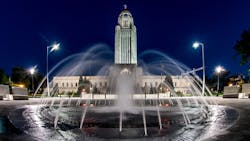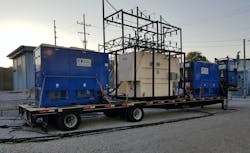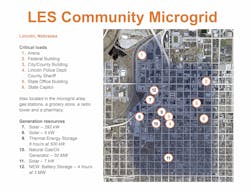Microgrid Fuels Nebraska Capital in Public Power Tradition
Some ideas make too much sense to ignore. That was the feeling in 2016 when Lincoln Electric System first investigated the concept of constructing a 29 MW community-owned, microgrid to bolster local disaster-recovery efforts in the downtown Lincoln, Nebraska area.
The idea was born from two basic factors. First, project planners realized early on that there was an inherent synergy on the grid in the form of an anchor generation source — the J Street generation plant — owned by the utility and supplemental customer-owned generation, all situated near numerous vital city, county and state facilities. Second, this was an opportunity to enhance a community-centric mindset fostered by LES’ relationship with the county, city and its customer-owners.
Lincoln is the capital of Nebraska, which is the only 100% public power state in the country. Every electric utility in the Cornhusker state is customer owned and run by Nebraskans rather than being owned by big, out-of-state companies.
This is a tradition that goes back to the early 20th century, when Nebraska Sen. George William Norris pushed to pass the Rural Electrification Act, which was eventually signed by President Franklin D. Roosevelt in 1936.
Lincoln, also called the Star City and part of the Silicon Prairie, is a picture of the Midwest. A growing mid-sized urban area in the middle of the country, the city manages to maintain a small town, community feeling despite the nearly 300,000 residents who call it home.
The Makings of a Microgrid
In short, the pieces were already in place. The utility realized it had what you could see as an almost ready-made microgrid already, but until then nobody had quite looked at it that way until a series of conversations in 2016 sent things into motion.
LES planners believe many utilities around the country may be in the same situation, already owning and operating resources that could further enhance system resiliency. The U.S. Department of Energy agrees, and featured the project in a publication to use as an example of how other communities might use their own similarly situated power assets.
From there, it was just a question of how to link these together in a way that made the local grid — and community it serves — stronger.
Lincoln’s electricity demands are met in part by two power plants outside the city, and it is located near major transmission lines. Major outages are a rarity for the utility, but tornadoes and other severe weather have the potential to do a lot of damage without much warning. It only takes one such incident to put a city and its utility in front of national news attention.
The capitol area is home to many institutions critical to the city and the region, including the Nebraska State Capitol, the headquarters for the Lincoln Police Department and Lancaster County Sheriff, Nebraska State Office Building, the Federal Building and Pinnacle Bank Arena.
Bringing Pieces Together
Nebraska sees weather extremes from all four seasons. A community microgrid could be a major benefit should the need for local disaster recovery arise. Whether the area experiences an extreme ice storm causing major damage to utility infrastructure, or a tornado ripping through the area, the ability to disconnect the microgrid and operate it autonomously from the rest of the electric system is invaluable. Not only can this help strengthen grid resilience, providing service to a finite area of critical infrastructure and facilities can also help to mitigate the impacts of a crisis for the entire community.
The area encompasses several advantages for remaining energized in the event of an emergency. First among these is a 30-MW oil- or natural gas-fired combustion turbine that anchors the project. Customer-owned resources around the microgrid, including five solar photovoltaic installations totaling just over 300 kilowatts, could supplement operations. Nearby thermal energy storage — the electrical equivalent of nearly 500 kW for 6 hours — could account for roughly 3,000 kWh of load shed.
The thermal energy storage stems from several District Energy plants that already provide low-cost, reliable and efficient heating and cooling to enhance economic development of the community in Lincoln. This thermal energy system allows one plant to build ice overnight which is used to supplement traditional cooling systems in the afternoon of the next day.
And, though likely unable to connect in parallel with the microgrid’s anchor generator, multiple customer-owned diesel backup generators could still be used to defer load during peak times, further adding to the area’s potential as a community microgrid.
Implementation
The ability to independently operate critical facilities as an island when the grid is down simply held too much value to sit idle for long though. Two years later, in 2018, the microgrid concept was revived with one simple, yet crucial, change in methodology. Instead of attempting to isolate and restrict service to only critical facilities in the downtown area, the microgrid would serve nearly all the load within a finite perimeter.
While this change in approach may limit the total load potential for critical facilities, the simplicity of the design was more than able to address the switching issues that previously
rendered the project unworkable.
The area typically serves the following loads that could potentially be critical during disaster recovery efforts:
- City, county, state and federal government facilities, including the city police department and county sheriff.
- The Pinnacle Bank Arena — 15,500-seat indoor arena in the West Haymarket District
of Lincoln — which could potentially serve as an emergency staging area during catastrophic events. - District Energy heating and cooling plants that serve most of the facilities above.
Although not as critical to government function, the area also includes valuable community support infrastructure, including a radio tower, which could be operated locally to support emergency communications, a small grocery store, a small pharmacy and multiple gas stations.
LES used two 5-MW load banks to perform testing on the microgrid’s anchor generator in the fall of 2020, confirming its ability to operate independently from the rest of the electric system while picking up large portions of load. With that confirmation, LES’ community microgrid was declared in service.
After completing load bank testing to support the microgrid, LES staff opted to begin testing all of the utility’s local generating stations to ensure their operations during system recovery efforts.
Onboarding Energy Storage
To further support the microgrid, LES issued an open request for proposals for a battery storage system to be located in the area. LES had been looking to do a small energy storage project and siting it within the microgrid provided another benefit stream to help justify a pilot. The storage system would be contracted under a power purchase agreement.
In June 2023, LES executed a contract with Wattmore, a Colorado-based clean technology and renewable project development company. The 3-MW, 4-hour battery they proposed is scheduled to be installed in downtown Lincoln by 2025.
When not supporting the microgrid, LES anticipates the battery being used to provide additional system benefits, including load-related energy arbitrage and ancillary services.
Bringing a battery storage project onboard would strengthen the LES microgrid while supporting transmission and distribution system reliability by deferring load during peak periods.
Scott Benson ([email protected]) is manager, Resource & Transmission Planning, at Lincoln Electric System.
Kelley Porter ([email protected]) is manager, Customer & Corporate Communications, at Lincoln Electric System.
About the Author
Kelley Porter
Kelley Porter is manager, Customer & Corporate Communications, at Lincoln Electric Systems.
Scott Benson
Scott Benson is manager, Resource & Transmission Planning, at Lincoln Electric Systems.




